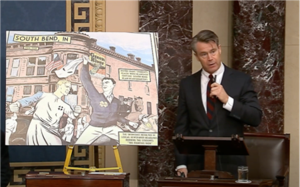Friday marks 100th anniversary of the Fighting Irish
- Staff Report-STATEHOUSE FILES

On May 17-19, 1924, the Ku Klux Klan rallied in South Bend with the intention of intimidating Catholics. During a three-day show of resistance, students from the University of Notre Dame confronted members of the KKK.
“It was 100 years ago this week—in an act of defiance against religious intolerance—that the Fighting Irish truly came into being. On this day, we remember their bravery in exercising their most basic of American freedoms as we celebrate the day they put the ‘fight’ in the University of Notre Dame Fighting Irish,” said Young, according to a press release.
To watch Young’s floor speech, click here.
Young’s full remarks are below:
Mr. President, 100 years ago this week, a legend was born.
One hundred years ago, the champions of religious freedom refused to back down in the face of intolerance and hate.
One hundred years ago today, the University of Notre Dame earned the moniker “the Fighting Irish.”
On May 17, 1924, thousands of members of the Indiana Chapter of the Ku Klux Klan gathered in South Bend, Indiana, for a rally called by their infamous leader, D.C. Stephenson.
The target that day for their despicable and misguided message of “true Americanism” was the Catholic institution of the University of Notre Dame, the young men who attended the university, and the Holy Cross priests who taught at it.
In the years that immediately preceded that fateful day, the KKK had watched with despair as Coach Knute Rockne and his football “Ramblers” had barnstormed across the country, winning praise for their fighting spirit and the university.
Mr. President, we can’t forget that, at the time, Catholics were a major target for the KKK in the Midwest.
And Notre Dame’s success on and off the field was an affront to the Klan’s false message of superiority.
And so, the KKK gathered outside the Golden Dome for what was to be a three-day rally, complete with a parade, speeches, dances … and no small amount of overtly violent intimidation.
They weren’t used to anyone standing up to them. They weren’t expecting anyone to stand up to them.
Little did they know that the mostly Irish Catholic student body across the street had no intention of being intimidated.
Little did they know that the students were so animated that the university president, Father Matthew Walsh, a World War I veteran, had been trying in vain to tell his students to stay safe and shelter in the school.
Little did the KKK know that on that day, the intended aspersion that the student body had co-opted as their preferred nickname—the Fighting Irish—was about to reach a national audience.
As the story goes—no doubt colored with some apocryphal additions over the years—the Klansmen began arriving in South Bend and hundreds of students marched out to meet them.
At first, the students almost playfully offered to assist the Klansmen in finding lodging and food, sometimes leading them down alleys, other times leading them back out of town.
However, when one KKK leader evidently became wise to the ruse and pointed a pistol at a student who had intended to pull down the unsacred cross of lights hung in a downtown third-floor window, well, as they say, all hell broke loose.
Klansmen that chose to fight quickly met their match and scrambled out of town.
Students grabbed produce—yes, even potatoes—from a local vegetable stand and hurled them at the cross, taking out all but the uppermost bulb.
At that moment, legendary “Four Horsemen” quarterback Harry Stuhldreher launched an impossible shot.
He threw a potato 40 feet in the air at the bulb, successfully darkening the last unholy light.
Moments later, the rest of the Klansmen were run out of town, tails between their legs. A subsequent exchange the next day led to another route by Notre Dame, running their record to 2-0 against the Klansmen that weekend.
That weekend, in describing the Notre Dame student body’s takedown of the most vaunted KKK chapter in the country, several national papers seized on the “Fighting Irish” moniker that had previously only been applied to the football team.
If you are interested in more details about that fateful weekend, Notre Dame alum Todd Tucker has written an acclaimed book entitled “Notre Dame vs. The Klan.”
Events like the one that took place in South Bend, Indiana, often prove to be historical inflection points.
In early 1924, intolerance and hatred were on the rise, not just in Indiana but across the country. For many, it was easier to give in to the fear of an uncertain future than to work to build a better community.
But Indiana and the country were soon to turn a corner, and the timing couldn’t have been more poetic.
Rockne, Stuhldreher, and the rest of the Fighting Irish football team would pull off a perfect 10-0 season later that year en route to the 1924 national championship.
And the Indiana Chapter of the KKK would quickly fizzle after the rape and murder conviction of its leader, D.C. Stephenson, the next year.
As for the university itself and its brave and proud student body: It would be three more years before Father Walsh would reluctantly give in to the wave that started that May day in 1924 and officialize the nickname—the Fighting Irish.
But make no mistake. It was 100 years ago this week—in an act of defiance against religious intolerance—that the Fighting Irish truly came into being.
And so, Mr. President, on this day, we remember their bravery in exercising their most basic of American freedoms as we celebrate the day they put the “fight” in the University of Notre Dame Fighting Irish.





